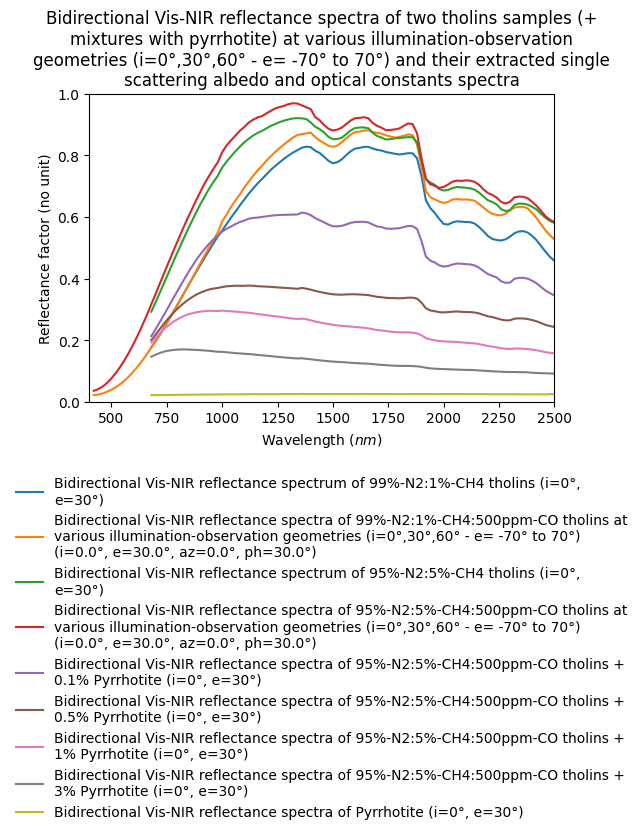- Title
- Bidirectional Vis-NIR reflectance spectra of two tholins samples (+ mixtures with pyrrhotite) at various illumination-observation geometries (i=0°,30°,60° - e= -70° to 70°) and their extracted single scattering albedo and optical constants spectra
- DOI
- 10.26302/SSHADE/EXPERIMENT_BS_20201201_001
- Data reference
- Fayolle, Marie; Quirico, Eric; Potin, Sandra (2018): Bidirectional Vis-NIR reflectance spectra of two tholins samples (+ mixtures with pyrrhotite) at various illumination-observation geometries (i=0°,30°,60° - e= -70° to 70°) and their extracted single scattering albedo and optical constants spectra. SSHADE/GhoSST (OSUG Data Center). Dataset/Spectral Data. https://doi.org/10.26302/SSHADE/EXPERIMENT_BS_20201201_001
- Comments
- submitted
- Database(s)
- Experimentalists
- Type(s)
- laboratory measurement
- Description
- Bidirectional Vis-NIR reflectance spectra (0.4-2.5 µm) of two tholins samples (99%-N2:1%-CH4:500ppm-CO and 95%-N2:5%-CH4:500ppm-CO) at various illumination-observation geometries (i=0°,30°,60° - e= -70° to 70°, step 10°) and their extracted single scattering albedo and optical constants spectra. Also series of 13 mixtures with pyrrhotite (from 1ppm to 5%)
- Number of spectra
- 21
- Variable type(s)
-
- sample composition
- sample abundance
- illumination-observation geometry
- spectrum type
- Comments
- 4 tholins composition, 13 mixtures with pyrrhotite, 3 incidence angles, 14 emergence angles, 3 spectrum types
- Instrument
- SHADOWS Spectro-Gonio bidirectional reflection Vis-NIR
- Sample holder
- open sample holder (12 mm diameter, 6 mm deep) in anodized aluminum
- Standard medium
- vacuum
- Observation mode
- spectrum
- Spectral range type(s)
- Vis, NIR
- Valid spectral range(s)
-
Min - Max ($nm$) Sampling ($nm$) Resolution ($nm$) Position accuracy ($nm$) Absorption edge #1 400.0 - 660.0 20.0 4.8 0.5 #2 680.0 - 1420.0 20.0 9.6 1.0 #3 1440.0 - 2500.0 20.0 19.2 2.0 - Comments
- a set of high pass filters at the monochromator output to filter the higher orders
Definition: incidence and emergence angles are positive with origin at nadir, and vary in same direction. Azimuth origin (increasing clockwise) is for i = e (opposition geometry).
- Observation geometry
- bidirectional
- Observation mode
- two variable angles
- Resolution illumination
- 5.8°
- Resolution observation
- 4.1°
- Comments
- angular resolution is full width
Illumination
Observation
- Comments
- partial polarization variable with wavelength (from monochromator grating)
- Observation mode
- single spot
- Image size
- 5.2 x 5.2 $mm$
- Instrument
- SHINE Spectro-Gonio bidirectional reflection Vis-NIR
- Sample holder
- open sample holder (12 mm diameter, 6 mm deep) in anodized aluminum
- Standard medium
- vacuum
- Observation mode
- spectrum
- Spectral range type(s)
- Vis, NIR
- Valid spectral range(s)
-
Min - Max ($nm$) Sampling ($nm$) Resolution ($nm$) Position accuracy ($nm$) Absorption edge #1 680.0 - 1380.0 20.0 9.6 1.0 #2 1400.0 - 2500.0 20.0 19.2 2.0 - Comments
- a set of high pass filters at the monochromator output to filter the higher orders
Definition: incidence and emergence angles are positive with origin at nadir, and vary in same direction. Azimuth origin (increasing clockwise) is for i = e (opposition geometry).
- Observation geometry
- bidirectional
- Observation mode
- fixed angles
- Incidence angle
- 0.0°
- Emergence angle
- 30.0°
- Azimuth angle
- 0.0°
- Phase angle
- 30.0°
- Resolution illumination
- 5.8°
- Resolution observation
- 4.1°
- Comments
- angular resolution is full width
Illumination
Observation
- Comments
- partial polarization variable with wavelength (from monochromator grating)
- Observation mode
- single spot
- Image size
- 7.5 x 7.5 $mm$
- Date begin - end
- 2018-06-28 - 2018-08-17
Versions
- Release date
- 2021-06-02 08:37:16+0000 UTC
- Version (Date)
- #1 (2021-06-02 08:37:16+0000 UTC, Updated: 2021-06-02 08:37:16+0000 UTC)
- Sponsors
-
- Centre National d’Etudes Spatiales (CNES) (Ralph / New Horizons)
- Agence Nationale de la Recherche (ANR) (CLASSY)
